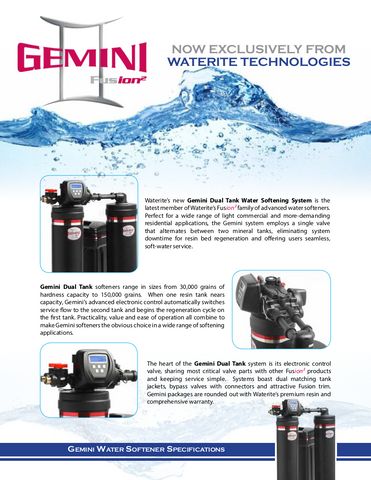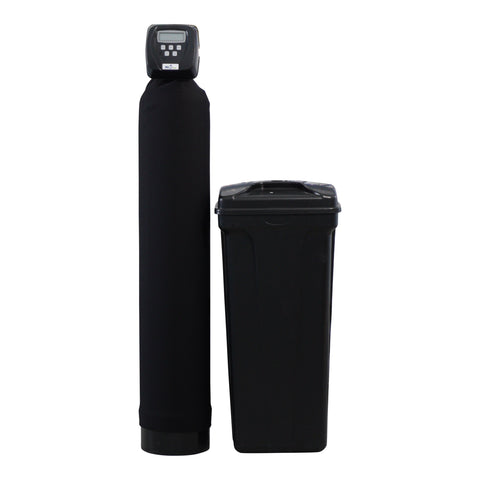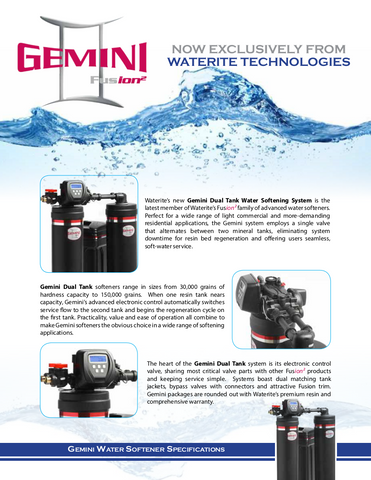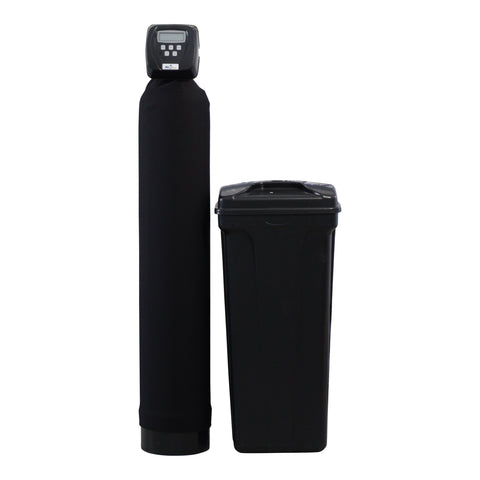
If you have a water softener at home, perhaps your water softener is suddenly regenerating much more often -- or not at all!
To fully understand today's blog and video, it's best to have an understanding of what water softener regeneration is. In case you don’t know, check out my YouTube video here first.
METERED WATER SOFTENERS

In a water softener brine tank, salt and water is used to make brine. The brine is used to recharge or regenerate the media beads. The more water you and your family use, the more often your water softener needs to regenerate the media.
Most modern water softeners are the metered water softeners (or demand initiated type) which means they measure how much water you use and regenerate based on their settings. Once you’ve used up their capacity of soft water and start getting into the reserve capacity, they schedule a regeneration based on the next REGEN time setting.
TIME CLOCK WATER SOFTENERS
The other type of water softener is a time clock water softener, which is exactly as it sounds. If you’re unfortunate enough to have a time clock water softener you need to do more calculations to determine best settings. I say "unfortunate" because those water softeners are not very efficient.
As water usage often varies in households, you end up either regenerating too frequently to make sure you have enough soft water between regenerations, or not often enough when you have higher demand because you’ve suddenly used more water due to more people being in the home or more water usage or for other reasons.
You can tell if your water softener is metered or time clock by looking to see if there is a cable running from behind the valve into the valve -- that likely means it’s metered. Most electronic water softeners will indicate water flow through the valve, so just run some water to see if that is the case with yours.
HOW TO DETERMINE SETTINGS

To calculate your REGEN settings, you’ll need the following information:
-
Hardness in grains per gallon (gpg) [parts per million (ppm) divided by 17]
--> 12 Iron in ppm = 1.5 - Number of people in family --> 4 people
- Manganese in ppm --> 0.5 ppm
- Softener size --> 40,000
If you’re investing in one of our HUM water softeners, which are all metered and come pre-programmed, you just need to calculate the compensated hardness number as follows:
- Hardness in gpg (grains per gallon) – example: 12
- Multiply the Iron in ppm (parts per million) by 4 – example: 1.5ppm x 4 = 6
- Multiply the Manganese in ppm by 6 – example: 0.5ppm x 6 = 3
- Tally up #1-3 to get Compensated Hardness – example: 12 + 6 + 3 = 21
Then just enter the Compensated Hardness Number (i.e. 21) for hardness in your water softener settings and you’re done!
Now based on your water usage, your water softener will regenerate either based on your usage or every 14 days, whichever comes first.
If you have a Time Clock water softener, you’ll need to do a bit more calculating. Check out the step-by-step calculation tips in today's blog video below!
After watching the blog video, you will see there is significantly more involved to correctly setting up a Time Clock water softener compared to metered water softener.
Either way, you need to know your water chemistry to setup your water softener to make sure it operates efficiently. Ideally, if your water softener is sized correctly, it will regenerate every few days but at least once every 14 days. If this is not the case, check out my troubleshooting tips below.
WATER SOFTENER TROUBLESHOOTING:
- If it’s programmed correctly but it regenerates every night, it’s too small.
- If yours is a metered softener and suddenly it’s regenerating far more often than usual be sure to check for leaks in your household plumbing --especially a toilet that doesn’t shut off.
- Not regenerating at all? Maybe the meter has stopped working.
Have more questions? Need further help with your water softener installation or maintenance? Check out our extensive how-to video playlists at GarytheWaterGuy,com or reach out to us here.
CLICK HERE TO SHOP WATER SOFTENERS
Click here for your next video on water softeners and I’ll see you there!
Video Transcript
Gary Beutler:
Do you know how often your water softener regenerates? Does it regenerate every night? How often should it regenerate? What determines the frequency of regeneration? Maybe it's regenerating a whole lot more often, or maybe it's not regenerating at all. I'm going to explain to you what determines frequency of regeneration and how you know if it's right for your family, starting right now.
Gary Beutler:
Hi, I'm Gary, the Water Guy, and I simplify water filtration to help you conquer crappy water for your family. Now, whether you're a homeowner, a water filtration specialist or a plumber, this video is definitely for you. So, the first step in understanding how often your water softener should regenerate is knowing what regeneration actually is. If you don't, I've got a great video that explains the whole process. I'll put a link in the description down below, and you definitely should check it out. So, basically, what regeneration is, is regenerating the media beads inside the media tank in your water softener. So, on an ongoing basis, water flows over those media beads. It softens the water by removing the calcium magnesium from the water to make it soft. But at some point, we have to clean out those beads and we have to regenerate the media, those media beads, and that's what regeneration process is.
Gary Beutler:
So, to calculate your regeneration settings, you're going to need some information. The first thing you're going to need to know is your hardness in grains per gallon. So, if you get that in parts per million, you just divide it by 17. For this example, we're looking at 12. Iron, you're going to need to know that in parts per million. So, for this example, we're looking at 1.5. You're going to need to know the number of people in the family. In this example, four. Number of people helps calculate how many gallons of water you use and how many gallons of water you'll be putting through that water softener. You're going to, the manganese content of the water in again, in parts per million. So, for this example, we're going to be using 0.5 parts per million of manganese and the softener size.
Gary Beutler:
Again, in this example, we're looking at 40,000 grains. So, with the information we have, we're going to calculate compensated hardness. So, for the hardness, in this example, it was 12. So, we're going to use that, but we're also going to use for, we're going to multiply the iron content, which is in parts per million by four. So, in this example, we have 1.5 parts per million of iron, so we're going to multiply by four, is going to equal six. Then, for the manganese, we have to compensate for the manganese in the water. So, again, in parts per million, so you multiply that by six. So, in this example is 0.5 times six is three, and so you need to total up those three numbers. So, you're going to add the compensated hardness, which is 12. You're going to add that to the iron that we're compensating for, so that's going to be a factor of six.
Gary Beutler:
Then, we're going to add the manganese that we're compensating for, which is a factor of three, so it's going to give us a total of 21. So, with a metered water softener, as you can see, it's quite straightforward to do the calculation and enter into the water softener. So, how do you know if you have a metered water softer or not? Well, a metered water software means that it's counting how many gallons of water you're using, and the other kind of water softener's the time clock water softener. So, a metered water softener has a meter built into it. So, in this Clack water softener here, you can see this cable, so the meters inside here and this cable runs into the unit. So, the easiest way to tell if your water softener is metered or not is just go somewhere in the house and run some water, and as that water is running and flowing through the meter, most metered water softeners, they flash to show you that it's sensing water movement.
Gary Beutler:
So, this is what the meter looks like here, and if I blow on it ... Let me just turn this a little bit, so you can see it a little bit better. Back a little bit. So, you see the word softening flashing up here, that's telling you that water is flowing through the water softener. Different water softeners don't ... This shows the word. This is a Clack WS1 valve on this Hume WaterCare water softener. It flashes the word softening on there. Some flash the word filtering. Some show water drops flowing through. Some show a flashing light, et cetera. So, like I say, go run some water somewhere, watch to see if something's flashing or something's moving on the screen, and then shut the water off and see if it stops.
Gary Beutler:
Now, it's a little bit of a time delay as you saw when I blew on this meter here to get it going. So, there's a little bit of a delay, so be a little bit patient, and the same when you stop on it, it takes a little while to stop registering. So, if you have a time clock water softer, and there's a lot more calculation to it. So, with the CLack water softeners, it's a three button, so as you can see here, there's three control buttons across the front, so that's known as a three-button valve. So, with the Clack three-button valve is strictly just used for filter. Now, with a time clock water softer, there's a whole lot more calculation that takes place. Now, unfortunately, most of the time, people don't go through that calculation. What they end up doing is they just end up guessing because as you can see, there's a lot of calculation here.
Gary Beutler:
Unfortunately, what often happens is they guess high. In other words, they set it to regenerate more often than it really should, because they don't want to have a callback, especially if it's a professional doing the job. They don't want to do the job, and then the people run out of soft water after a day or after two days, so they'll set it to regenerate more often than it actually should. So, of course, the problem with that is then the customer ends up using far more salt and far more water for regeneration over the next two, five, 10, 15 or 20 years. So, that's why we don't recommend a time clock valve for a water softener. But anyway, let's go through the calculation here. So, you can see the first thing is you need to multiply the number of people in the family by 75.
Gary Beutler:
That's the way we calculate the water usage. So, in this example, four times 75 is 300 gallons. We need to multiply the compensated hardness number times the waters usage to tell us how many total grains per day of water softener capacity we're using up. So, in this example is 21 times 300, 6300. We need to calculate the reserve capacity. So, again, with a metered water software, the electronic valve figures all that out for us, but with a time clock, we have to figure it out for them. So, we always calculate 20% reserve capacity. So, again, here we're looking at 7,560 compensated total grains per day. Since, water softeners are most efficient at two-thirds of their capacity, we multiply the softener size by 0.66, that's two thirds, and so 40,000 grain, a water softener, 26,400. Then we need to, the efficiency size divided by the compensated, so we get 3.5 days. Of course, we can't set it for three and a half days. We have to set it for the next one lower, which is three days.
Gary Beutler:
So, you can see why a time clock water softener is much less efficient than a metered water softener. Ideally, if your water softener is sized and programmed correctly, it'll regenerate about every three to five days, but at least once every 14 days. If it regenerates every night, it's just too small. If yours is a metered water softener, and suddenly it's regenerating far more often, check to see if you're using a lot more water. Maybe you've got more people there. Maybe it's Christmas time, and you have a lot of people over, or maybe you've got a leak somewhere in the plumbing system. Definitely, check those toilets. That toilet may be running on, causing you to use far more water, and that's why it's regenerating more often. Not regenerating at all? Well, that means the meter's stopped working. Click over here for your next video on water softeners, and I'll see you there. Any questions or comments, put them down below.


















